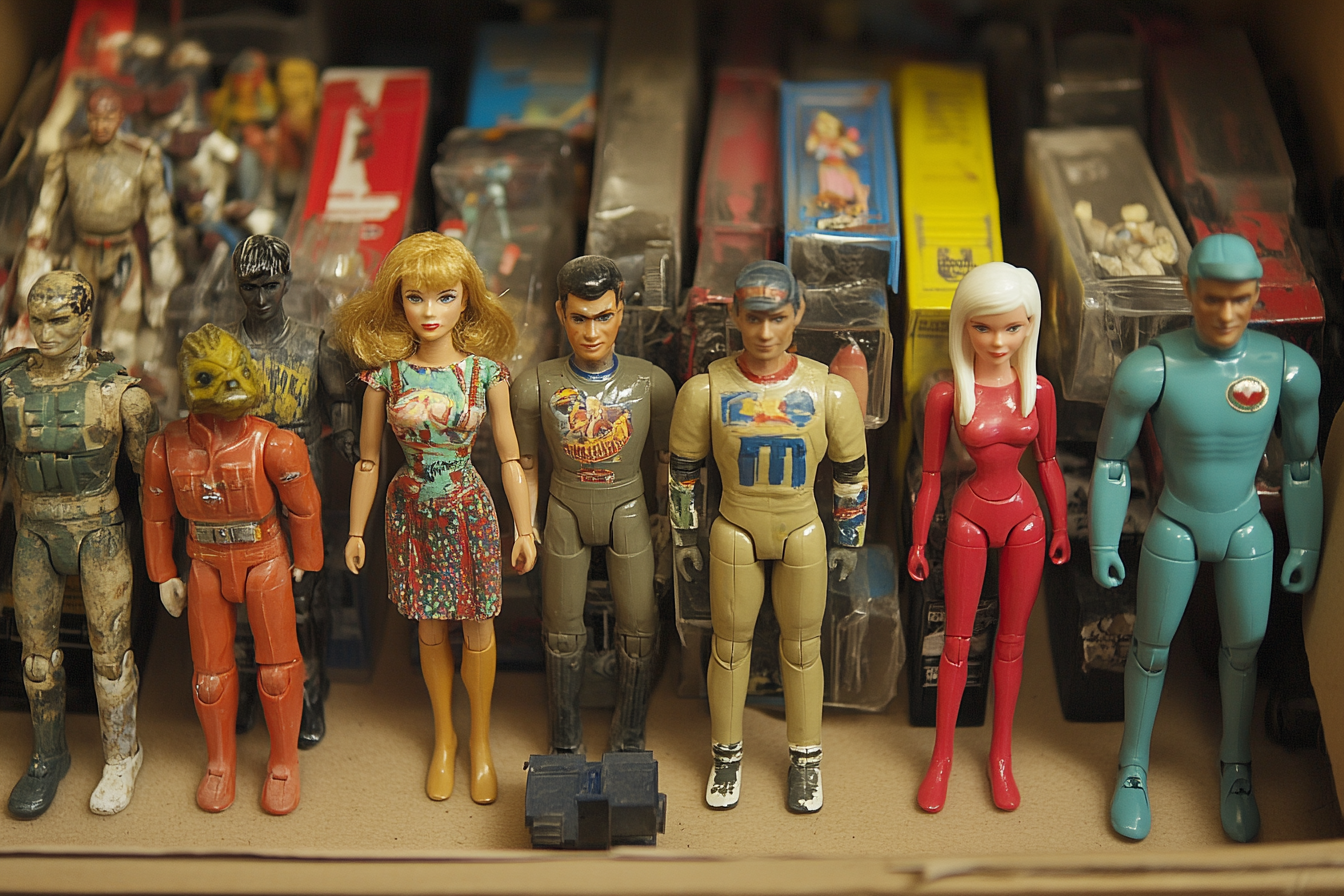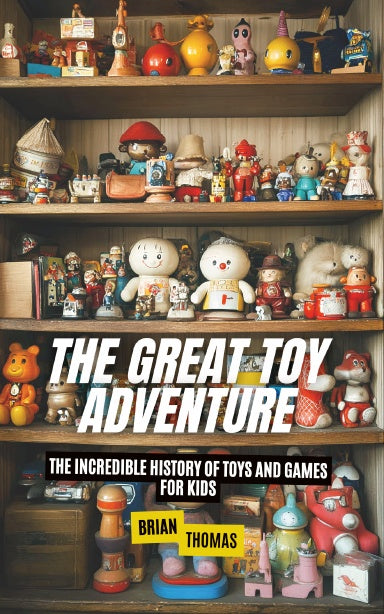
Excerpt
Introduction: Why Do We Love Toys?
Toys are everywhere. They fill bedrooms, classrooms, parks, and even grocery store aisles. They can be as simple as a ball or as complex as a video game system. Some are soft and cuddly, while others are made to race, build, or even talk. But no matter what kind of toy it is, there’s something about them that makes people—both kids and adults—want to play.
Playing isn’t just fun; it’s something humans have done for thousands of years. Long before people had factories or toy stores, they found ways to create things to play with. Ancient kids made dolls out of clay, carved animals from wood, and rolled stones like marbles. Even grown-ups throughout history have had their own versions of play, from board games to model-building. There’s a reason for that. Play isn’t just about keeping busy—it helps people learn, imagine, and connect with others.
What Makes Something a Toy?
A toy doesn’t have to come in a box or have a brand name. If it’s something people use for play, it counts. A stick can become a sword, a spaceship, or a wizard’s staff. A cardboard box can be a castle, a car, or a secret clubhouse. Some toys are designed for specific games, like chess pieces or action figures, but others are just everyday objects that people turn into something fun.
Toys can also be different for different people. A teddy bear might be the perfect toy for someone who likes soft and comforting things, while a remote-control car might be more exciting for someone who loves speed. Some people like toys they can build with, like LEGOs or blocks, while others prefer toys that let them create stories, like dolls and playsets. There’s no single definition of what makes a “good” toy—if it brings fun and sparks creativity, it’s doing its job.
Why Do People Love Playing?
At first, it might seem like only kids love toys, but that’s not really true. People of all ages like to play, even if the way they play changes over time. Kids might enjoy stuffed animals and board games, while older people might get into puzzles, sports, or video games. Even adults like to collect and build things, whether it’s model airplanes, trading cards, or video game systems.
Playing helps people in ways they don’t always realize. It makes learning easier, because it’s more fun to figure things out when it feels like a game. That’s why young children use toys like blocks to understand math and puzzles to improve problem-solving skills. Even scientists and engineers use a kind of play when they test ideas and experiment with new inventions. Play is how people explore and make sense of the world.
Toys also help people connect. A group of kids can work together to build something out of LEGO, compete in a board game, or make up a pretend adventure with action figures. Even when people grow up, they often still enjoy playing games with friends, whether it’s a card game, a team sport, or a video game. Play has always brought people together, and toys are a big part of that.
The Toys That Stick With Us
Some toys are fun for a little while and then get replaced with something new. Others stick around for years or even lifetimes. Think about the toys that never seem to go away—classic things like dolls, marbles, jump ropes, or toy cars. These have been around for generations, and people keep playing with them because they’re simple, open-ended, and fun.
Then there are the toys that hold special meaning. A stuffed animal from childhood, a favorite game played with family, or a collection built over time can all be important in ways that go beyond just having fun. Toys can remind people of happy memories, like building a favorite set of blocks with a parent or playing a game every summer with cousins. Some people even keep their old toys long after they stop playing with them, just because they bring back good feelings.
The role of toys in learning and creativity
Toys are fun, but they do a lot more than just pass the time. Whether it’s building, pretending, solving puzzles, or figuring out how things work, toys help people learn in ways that don’t feel like school. They make it easier to understand new ideas and encourage creativity by letting people experiment and try new things.
Playing with toys teaches skills without feeling like work. A game of chess improves strategic thinking. A set of building blocks teaches problem-solving. Even something as simple as a ball helps with coordination. Toys are designed for fun, but they also shape the way people think, move, and understand the world.
Building Blocks of Learning
Playing with toys is often the first way people start learning about the world around them. Long before reading books or doing math problems, people explore shapes, colors, and cause-and-effect through play. A baby dropping a toy over and over again is figuring out gravity. A toddler stacking blocks is learning balance and structure. Even games like peekaboo teach early problem-solving, like knowing that something can disappear and come back.
Building toys are some of the best examples of learning through play. Whether it’s wooden blocks, LEGOs, or magnetic tiles, stacking and connecting pieces teaches everything from patience to engineering. When a structure falls over, it’s not a failure—it’s a lesson. Trying again and making small changes is the same kind of thinking that scientists and inventors use.
Other toys teach through patterns and puzzles. A Rubik’s Cube, for example, looks like just a colorful block, but solving it requires recognizing patterns and thinking ahead. Board games like checkers or chess help with strategy, planning, and predicting what might happen next. Even a simple jigsaw puzzle improves problem-solving by forcing people to figure out how different pieces fit together.
Toys are everywhere. They fill bedrooms, classrooms, parks, and even grocery store aisles. They can be as simple as a ball or as complex as a video game system. Some are soft and cuddly, while others are made to race, build, or even talk. But no matter what kind of toy it is, there’s something about them that makes people—both kids and adults—want to play.
Playing isn’t just fun; it’s something humans have done for thousands of years. Long before people had factories or toy stores, they found ways to create things to play with. Ancient kids made dolls out of clay, carved animals from wood, and rolled stones like marbles. Even grown-ups throughout history have had their own versions of play, from board games to model-building. There’s a reason for that. Play isn’t just about keeping busy—it helps people learn, imagine, and connect with others.
What Makes Something a Toy?
A toy doesn’t have to come in a box or have a brand name. If it’s something people use for play, it counts. A stick can become a sword, a spaceship, or a wizard’s staff. A cardboard box can be a castle, a car, or a secret clubhouse. Some toys are designed for specific games, like chess pieces or action figures, but others are just everyday objects that people turn into something fun.
Toys can also be different for different people. A teddy bear might be the perfect toy for someone who likes soft and comforting things, while a remote-control car might be more exciting for someone who loves speed. Some people like toys they can build with, like LEGOs or blocks, while others prefer toys that let them create stories, like dolls and playsets. There’s no single definition of what makes a “good” toy—if it brings fun and sparks creativity, it’s doing its job.
Why Do People Love Playing?
At first, it might seem like only kids love toys, but that’s not really true. People of all ages like to play, even if the way they play changes over time. Kids might enjoy stuffed animals and board games, while older people might get into puzzles, sports, or video games. Even adults like to collect and build things, whether it’s model airplanes, trading cards, or video game systems.
Playing helps people in ways they don’t always realize. It makes learning easier, because it’s more fun to figure things out when it feels like a game. That’s why young children use toys like blocks to understand math and puzzles to improve problem-solving skills. Even scientists and engineers use a kind of play when they test ideas and experiment with new inventions. Play is how people explore and make sense of the world.
Toys also help people connect. A group of kids can work together to build something out of LEGO, compete in a board game, or make up a pretend adventure with action figures. Even when people grow up, they often still enjoy playing games with friends, whether it’s a card game, a team sport, or a video game. Play has always brought people together, and toys are a big part of that.
The Toys That Stick With Us
Some toys are fun for a little while and then get replaced with something new. Others stick around for years or even lifetimes. Think about the toys that never seem to go away—classic things like dolls, marbles, jump ropes, or toy cars. These have been around for generations, and people keep playing with them because they’re simple, open-ended, and fun.
Then there are the toys that hold special meaning. A stuffed animal from childhood, a favorite game played with family, or a collection built over time can all be important in ways that go beyond just having fun. Toys can remind people of happy memories, like building a favorite set of blocks with a parent or playing a game every summer with cousins. Some people even keep their old toys long after they stop playing with them, just because they bring back good feelings.
The role of toys in learning and creativity
Toys are fun, but they do a lot more than just pass the time. Whether it’s building, pretending, solving puzzles, or figuring out how things work, toys help people learn in ways that don’t feel like school. They make it easier to understand new ideas and encourage creativity by letting people experiment and try new things.
Playing with toys teaches skills without feeling like work. A game of chess improves strategic thinking. A set of building blocks teaches problem-solving. Even something as simple as a ball helps with coordination. Toys are designed for fun, but they also shape the way people think, move, and understand the world.
Building Blocks of Learning
Playing with toys is often the first way people start learning about the world around them. Long before reading books or doing math problems, people explore shapes, colors, and cause-and-effect through play. A baby dropping a toy over and over again is figuring out gravity. A toddler stacking blocks is learning balance and structure. Even games like peekaboo teach early problem-solving, like knowing that something can disappear and come back.
Building toys are some of the best examples of learning through play. Whether it’s wooden blocks, LEGOs, or magnetic tiles, stacking and connecting pieces teaches everything from patience to engineering. When a structure falls over, it’s not a failure—it’s a lesson. Trying again and making small changes is the same kind of thinking that scientists and inventors use.
Other toys teach through patterns and puzzles. A Rubik’s Cube, for example, looks like just a colorful block, but solving it requires recognizing patterns and thinking ahead. Board games like checkers or chess help with strategy, planning, and predicting what might happen next. Even a simple jigsaw puzzle improves problem-solving by forcing people to figure out how different pieces fit together.


